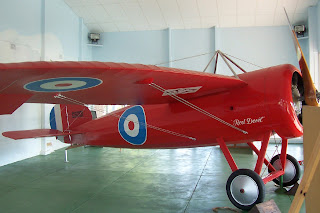Captain Harry Butler's original Bristol M1C is housed on static display in a purpose built museum in Minlaton, South Australia. It may be viewed at any time through the glass windows of the display. On application to the Minlaton District Council, supervised access to the display for closer inspection may be arranged.
The 'Red Devil' as we see it today is not entirely in its original condition; that is it is not as it was when first constructed as Serial Number C5001.
Colin Owers in his excellent article 'The Bristol M.1 Monoplane' notes:
"Contract No. AS 8236 was let for 125 Bristol monoplanes as the M.1C, (Serials C4901 - C5025). The engine was now a 110 hp Le Rhone and the length 20 foot 5½ inch. The Vickers gun, synchronised by a Sopwith Kauper interrupter gear, was mounted on the fuselage centreline where it was in easy reach of the pilot to clear stoppages. Wing root cutouts were incorporated in both wings which were modified from the M.1A. Leading edge riblets were carried to the end of the wing and extra ribs were added near the ailerons.
C5001 was purchased from the Aircraft Disposal Board by Harry Butler in partnership with H.A. Kauper (Harry Hawker's assistant), together with an Avro 504 and three Le Rhone engines. Butler had flown C5001 at the No. 4 School of Aerial Gunnery at Marske-by-the-Sea, Yorkshire. When disposed of by the Aircraft Disposal Board C5001 had only flown 28 hours and 35 minutes. The aircraft were shipped back to South Australia and assembled in Adelaide. Butler flew C5001 back to his home town of Minlaton on 6 August 1919 to a tumultuous welcome. Five days later he flew two bags of mail back to Adelaide. Butler barnstormed the M.1C around South Australia and flew it to victory in the Peace Loan Aerial Derby held at Adelaide on 8 September 1920. The aircraft was initially flown in its service markings but by the 1920s was known as the "Red Devil" and it is assumed to have been painted red at some time. On 28 June 1921 it was registered as G-AUCH.
Butler stored the Bristol in his motor garage at Minlaton, and it was withdrawn from the register on 27 June 1922. After Butler's death in 1924 the Bristol remained in storage until purchased by "Horrie" Miller in 1930. He moved to Parafield, South Australia, where it was modified to take a Gipsy I in-line engine and the fuselage given flat sides. In this guise it was registered VH-UQI on 15 October 1931. Named "Puck" by Miller, the Bristol was flown to victory in the 1931 and 1932 Adelaide Aerial Derbys. The engine was changed to a Gipsy II and finally a Gipsy III. It was struck off the register in 1936 after the Department of Civil Aviation refused to grant it a Certificate of Airworthiness. It was still flown on occasion by Miller who was granted a permit to fly it to Perth, Western Australia in 1940. It was flown during and after the war and then suspended from a hangar roof at Guildford. C.B. Tubrook of Minlaton noticed it in 1956 and negotiated for its return. Miller gave the aircraft to the town of Minlaton. A special building was erected to house the aircraft after restoration to its appearance when it was used by Miller. In 1973 a partial restoration was undertaken which saw the Gipsy engine removed and a Le Rhone rotary fitted but the slab sides were retained. As it now appears it is a strange mixture, but as it is the only surviving Bristol M.1 monoplane it is to be hoped that it will be fully restored in the future. "
Separately, it has been found the "Red Devil" in its modified form was described as a 'Bristol M-1 Gypsy Racer'.
It is known that some variants were fitted with a full size spinner which afforded dust protection and aided streamlining. It is not however know if C5001 was ever fitted out this way. Inquiries and old photo searches are continuing.
The original colour scheme for the "Red Devil" is also subject to some speculation. G. Owers provides some insight to the colours ex factory and there are numerous references to personalized liveries. Research is continuing into when C5001 became known as "The Red Devil".

No comments:
Post a Comment